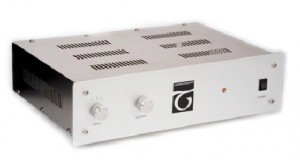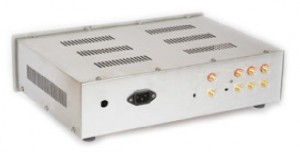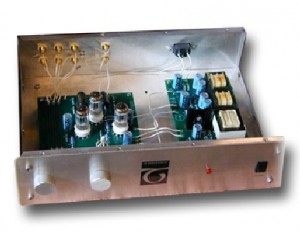Specifications:
- Harmonic Distortion: Less than .02% at 2 volts RMS out.
- Signal to Noise Ratio: Greater than 93 dB. Bandwidth: 1 dB down from 5 Hz to 300 kHz. Gain: 12 dB.
- Max Signal Out: 20 volts RMS. Output Impedance: 200 ohms. Input Impedance: 50 k Ohms.
- Inputs: 3, Outputs: 1, all single-ended, RCA Controls: Input Selector, Volume, Power Tube Compliment: 3-12AU7
- Dimensions Overall: 15’W by 11’D by 4 1/4’H. Weight: 10 pounds.
I first heard about Transcendent Sound’s Grounded Grid preamplifier through an amplifier designer from another company. I had been in the market for a new power amplifier and had a model on loan from Henry Ho, chief designer for and owner of H2O Audio. The H2O Audio amplifier had far surpassed the sound of my Bryston 4B-ST, but my tube preamplifier was not designed to drive an amplifier with a low input impedance. The input impedance of the H2O Audio amplifier is quite low, and the match had caused a receded soundstage and lack of dynamics. I told Henry of the problem, and he recommended that I might try one of two reasonably priced preamplifiers to solve the problem: the Adcom GFP-750 based on a Nelson Pass design, and the Transcendent Sound Grounded Grid designed by Bruce Rosenblit, holder of the Transcendent Patent of the Output-Transformer Less tube amplification output stage.
I had previously listened to the Adcom preamplifier with my Bryston amplifier. At the time it was my favorite of the group of solid-state preamplifiers that I could afford. But near the same time I discovered tube based preamplification, and generally found tube preamplifiers to be more to my liking when matched with the solid-state Bryston amplifier. Luckily, a friend of mine still owned the Adcom preamplifier so it was easy to secure a demo with the H2O Audio amplifier.
Transcendent Sound grounded grid preamplifier review
Finding a demo of the Grounded Grid was not possible, as it is currently only sold factorydirect from Transcendent Sound. The Grounded Grid can be bought as a kit for $499.00, or costs $799.00 for a fully assembled unit. I had long wanted to try building a piece of audio equipment from a kit, and impressions from other Grounded Grid builders were quite positive, so I decided to take a risk with the kit.
The Grounded Grid is not what is considered a fullfunction preamplifier. The unit employs three sets of line-level RCA inputs, a single set of RCA outputs, an input selector switch, a volume control, and a power switch. The labels on the input selector switch read “1”, “2” and “3”, each coinciding with the order of the RCA inputs on the back panel. There is no remote control, no tape loop, no home theater bypass, no phono-stage, no balance control and no mute switch.
Because I am reviewing the kit version of the Grounded Grid, I will give some background about my knowledge level of all things electronical. I have no formal background in electronics nor science in general. In my college days I studied English and philosophy and music and art (which is why I feel special dispensation for making up words such as “electonical”). I have, however, long had an interest in the sciences and have taken myself on various adventures of self-study in disciplines such as amateur astronomy and computer programming. I have learned enough about electronic schematics to follow the relatively simple schematics of speaker crossovers, but I find more complex schematics confusing. I can successfully avoid burning my fingers with the soldering iron when I have a need to plug it in, but I am in no means an artist with the tool.
That I successfully assembled the Grounded Grid in one afternoon / evening gives great praise for the layout of the kit and the clarity of the manual. A high quality soldering iron makes the job easier, and I also used a multi-meter to double check that I was using the proper resistors at each step. After working steadily for about six hours, a had a working preamplifier in my hands. I subsequently made some minor modifications to the unit, but that was the next day so more about those later.
The kit is packaged very well, with components pre-sorted by task. The designer of the kit recommends prereading all of the directions before starting to build the preamplifier, and I would also recommend pre-reading each section of steps as you come upon them. The manual is well written and clear, and assumes no previous electronics experience. At no time during the build process did I feel confused or unsure of whether I completed the process correctly.
After spending six hours with the soldering iron I was eager to plug the unit in and see if I would die in a flash of electrical sparks or at the very least burn my listening room to ashes. The power LED lit up with no snaps nor crackles, and not even a pop. I shut everything down and hooked it up to the system. I powered up the Grounded Grid, waited about 30 seconds and powered up everything else. Still no unsightly hums nor buzzes so I assumed everything was good to go.
The other tube preamplifier that I have long enjoyed in my system is an Audible Illusions Modulus 3A; a wonderful sounding unit that unfortunately would not drive the low input impedance of the H2O amplifier. With the Modulus 3A, I always had a bit of tube rush through the speakers when I turned the volume up loud with no musical signal. When I tried the same with the Grounded Grid I couldn’t hear anything. Hmmm, was this thing working? I put some music through the unit and, Oh Happy Day, it actually worked. I walked away to let the unit warm up for thirty minutes before serious listening.
Sometimes I can put a new component in my system and not hear much difference between the old and the new component. With other components, I can hear substantial differences but not always are the differences pleasing. When listening to new components, I like to leave them in place long enough to determine whether the differences will be satisfying long-term. Right off the bat I found the Grounded Grid to be pleasing but with differences in presentation from the sound I was used to. Now after seven months of listening, I can confidently say that the Grounded Grid not only offers lasting satisfaction, but is a tremendous value in comparison with more lavishly priced preamplifiers if you do not need the added features of fullfunction models.
While some preamplifiers excel at crystal-like clarity in the highs, or thunderous control at the low end of the spectrum, the Grounded Grid offers good performance in all parts of the frequency spectrum and excels at the portrayal of rhythm and the presentation of musical texture. In Lanterna’s “Desert Ocean”, Henry Frayne’s multilayered, reverb laden electric guitar riffs stay clear of becoming drippy new-age schmaltz, and instead offer swirling textures and floating tones mixed with a forward driving beat. The Grounded Grid does a tremendous job of retrieving the smooth tonal detail and warm ambiance in the recording, while allowing the forward pace of the music to keep the feet tapping. The Grounded Grid allows the pace of such music to flow freely because it is particularly free of falsely bloated bass, and remains dynamic, fast, open and smooth in both the midrange and treble full of detail but without the etched quality that can grind on the ear drums.
I don’t consider the sound stage of the Grounded Grid to be particularly forward nor receded. In fact, I have heard the preamplifier place instruments both well in front of and well behind the speakers dependant upon the recording I am listening to. The vibes in Caribbean Jazz Project’s “Birds of a Feather” stand nicely out in front of the decisively Afro-Cuban rhythm section, while the strings in Kronos Quartet’s “Early Music” are presented far behind the front plane of the speakers. The Grounded Grid excels at the natural presentation of strings such as in the aforementioned recording; there is a wealth of tonal detail without the synthesized feel I have heard from other solid state preamplifiers.
I have compared the Grounded Grid directly with three other preamplifiers that have received very high accolades in the press. I cannot consider the comparison apples to apples because while all of the other preamplifiers are more expensive, they also offer more features. In terms of sound quality however, the Grounded Grid competed very well if it did not outperform the more expensive units. I thought the Grounded Grid offered a more natural yet competitively dynamic sound when compared to the Adcom GFP-750. The Audible Illusions Modulus 3A has more presence and warmth in deep bass notes and slightly better stereo separation, but the Grounded Grid portrays rhythm better and offers even less glare in the middle and upper frequencies than the already excellent performance of the Modulus 3A. While the very expensive Audio Aero Prima SE is primarily a DAC, it also comes with the added features of multiple digital and analog inputs with source switching, a volume control and a tube output stage. The Prima SE offers the best midrange performance I have had the pleasure of listening to, but suffers from a little bit of bass looseness and bloat that effects some tube based preamps. The Grounded Grid sounds remarkably similar to the Prima SE used as a preamplifier, with slightly less midrange resolution but better resolution in the mid and upper bass.
When getting to the level of sound quality that the Grounded Grid offers, the comparisons to other well respected preamplifiers do not remain consistent when mating them with different amplifiers. With one amp I would like the sound of the Grounded Grid better, while with another amp I would like the presentation of the Prima SE slightly better. But the Grounded Grid is rather unique in its ability to sound good with any amplifier. I have paired it with the following amplifiers: B&K ST-140, B&K ST-202 Plus, Bryston 4B-ST, Musical Fidelity A3cr, Aragon 8008 and H2O Audio S250 Signature. The Grounded Grid sounds quite good with them all, and was the best preamp I’ve heard mated to the Aragon 8008, both B&K models, and the Musical Fidelity A3cr. I have not yet found an amplifier that the Grounded Grid would not drive, and the combinations were good across the board. The Grounded Grid does not offer the type of depth and control in the lowest bass that is evident in many solid state preamplifiers, but it does offer a tuneful and musical low-end. In this regard, the preamplifier mated very well with the Aragon 8008’s extreme control in the bass but rather limited extention on the treble. As well, the Grounded Grid made unexpectedly beautiful music when placed in a friend’s system consisting of the Musical Fidelity A3cr amplifier and Vandersteen Audio 2CE speakers. I was enjoying the quality of orchestral and jazz music so much that I didn’t want to leave.
One nice aspect about building a preamplifier from a kit is that you can change what you don’t like. Most of what I didn’t like about the Grounded Grid had nothing to do with the sound of the unit, but instead the look and feel of the preamplifier. My first quibble was with the volume control. I wanted more control at lower volume levels and the stock volume control also has a rather cheap tactile feel to it. Transcendent Sound offers a stepped attenuator kit which I ordered and built to replace the stock volume pot. The stepped attenuator kit uses an ELMA rotary switch and offers an excellent range of control at low volume levels. Building the stepped attenuator is not difficult, but it is rather tedious.
Second, I didn’t like the feel of the source selector switch, so I pulled out a high quality Grayhill rotary switch from a passive linestage I had built long ago and used it instead. Changing the switch does nothing for the sound, but does gives the unit a higher quality tactile feel.
Finally, I added a second set of RCA outputs so that I could drive a set of subwoofers along with the main system amplifier. All of these modifications raised the price of the final product about $200.00, and except for the volume control and additional set of outputs, had no effect on the sound of the preamplifier.
My only gripe with the Grounded Grid is a DC surge that occurs when turning the unit on, and a similar pop when switching the unit off. The simple solution is to make sure the amplifier is off when turning the preamp on and off, but my amplifier was designed with an annoying feature of its own, a power switch at the back of the unit. In all other ways the Transcendent Sound Grounded Grid offers sound quality comparable to products costing many times the price of even the fully assembled unit, but also offers the fun and engagement of building your own audio component in a well packaged, easy to build kit.
external link: http://www.transcendentsound.com/Transcendent/Transcendent_Sound_Grounded_Grid_Preamp.html
from affordableaudio





